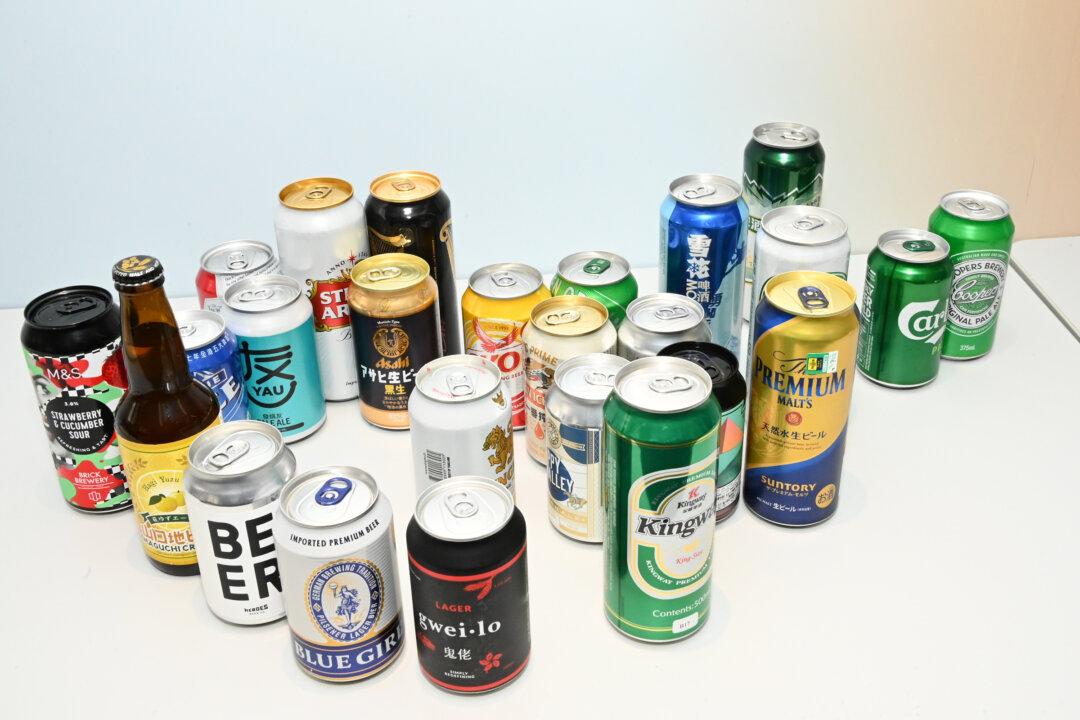The Hong Kong Consumer Council tested 30 beer samples on the market and found that all contained different types and levels of biogenic amines. Excessive intake of biogenic amines may cause headaches, dizziness, vomiting, and the like. One sample was even detected with the mycotoxin “DON,” excessive intake of which may cause symptoms such as nausea, vomiting, and abdominal pain.
The Consumer Council purchased 30 samples of prepackaged canned or bottled beer on the market. The prices per can or bottle range from HK$4.50 to $50 (US$0.6 to US$6.4), the volume ranges from 330ml to 500ml (11.2 fl. ounces to 17 fl. ounces), and the labeled alcohol (ABV) content between 3 percent and 8 percent. The test, this time, focuses primarily on the nutritional value, safety, and quality of the samples.
All with Biogenic Amines Detected
Tests by the Consumer Council found that different types and levels of biogenic amines were present in all samples. A total of seven biogenic amines were detected in the “Carlsberg Danish Pilsner” sample, in which agmatine (84.7 mg) and putrescine (47.6 mg) were considered relatively high; a total of five biogenic amines were detected in the “Coopers Brewery Original Pale Ale” sample, of which 32.8 mg of putrescine was detected, and the amount of agmatine was as high as 121.4 mg, making it the sample with the highest amount of a single biogenic amine detected.DON Detected in 1 Beer Sample
The test also found that deoxynivalenol (DON) was detected in the “HARBIN Mai Dao” sample, with the detected amount being 26 micrograms per kilogram. The Consumer Council stated that DON, also known as “Vomitoxin,” may cause nausea, vomiting, diarrhea, abdominal pain, fever, and other symptoms within 30 minutes after excessive ingestion. However, based on the level mentioned above detected, for an adult weighing 60 kg (132 lb.), boozing four cans in one day is still within the safe level.
Samples with High Alcohol Content Also Come with Higher Calories
Drinking too much beer can easily lead to a “pot belly.” Tests by the Consumer Council found that beers with high alcohol content are also accompanied by higher calories. The test refers to the EU regulations to calculate the energy content of the sample. Calculated per 100 ml, the calorie value of each sample ranges from 33 kcal to 66 kcal; calculated per can or bottle, it ranges from 112 kcal to 230 kcal. Among them, the samples with the highest energy (containing 66 kcal per 100 ml) and the second highest (containing 57 kcal per 100 ml) also had the highest (7.46 percent) and second highest (7.42 percent) alcohol content detected.The Consumer Council cited an example that a 330ml can of beer with an alcohol content of 5 percent contains about 13 grams (0.5 ounces) of alcohol, which is equivalent to the same calories as a bowl of white rice. Drinking two cans a day for three months means you will have absorbed about 16,500 kcal of energy from alcohol alone, which can be converted into about five pounds of fatty tissue.
In addition, the test found that the alcohol concentration detected in 20 percent of the samples (six brands) was quite different from the labeled value. The labeled alcohol content of all samples ranged from a minimum of 3 percent to a maximum of 8 percent, compared with the test results ranging from 3.39 percent to 7.46 percent.
The alcohol concentration detected in four of the samples was 0.5 percent or more above the labeled value, while the detected alcohol level in two samples was more than 0.5 percent below the labeled value. One of the samples was labeled as “more than or equal to 3.7 percent alcohol,” but the test result returned 4.67 percent, which was 0.97 percent different from the lowest value labeled.
The Consumer Council reminds the public that alcohol is a toxic substance that can cause chronic diseases such as hypertension, heart failure, stroke, liver cancer, cirrhosis, fatty liver, colorectal cancer, and impotence. The International Agency for Research on Cancer (IARC) under WHO has also classified alcohol as “carcinogenic to humans.”
Excessive intake of alcohol may affect brain function and self-control, so the risk of accidents caused by drunkenness will greatly increase. At the same time, alcohol also affects the carbohydrate metabolism of the liver and affects blood sugar levels, increasing the risk of diabetes and other diseases.






